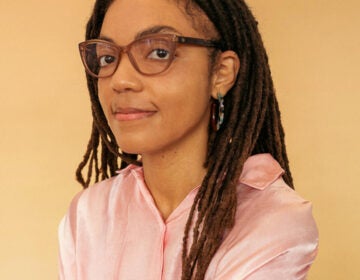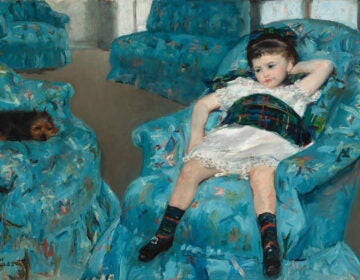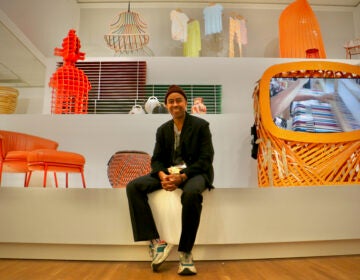‘Philadelphia Assembled’ marks finale at art museum’s Perelman Building
The massive, citywide civic engagement experiment will conclude with the production of a new play written for the project.
Listen 4:26
Artist Charlyn Griffith describes the creation of a mural exhibited at the Perelman Building of the Philadelphia Museum of Art as part of the citywide civic engagement project, Philadelphia Assembled. (Emma Lee/WHYY, file)
This weekend, the Philadelphia Museum of Art will conclude its massive, citywide civic engagement experiment, “Philadelphia Assembled,” with the production of a new play written for the project.
Playwright Mona Washington calls the play “Lacunae,” using the word meaning a pocket of empty space, or a gap, as metaphor for the little bit of flexibility needed when social and institutional ideologies collide.
“I think that the way change happens is, sometimes you have to rub up against something or someone that’s different,” she said. “When there’s enough space, you can learn. But sometimes you bump, and you break.”
The play has two parallel stories that meet at the end — one is about gentrification in Philadelphia neighborhoods, the other about a frazzled museum administrator who learns lessons from “The Moorish Chief,” a masterpiece painting by Eduard Charlemont, which comes to life.
The first seed of the play bloomed over the summer, when Washington had written a dozen short, pop-up plays for Philadelphia Assembled, meant to be performed in 12 locations around the city. In the end, only four of them were performed.
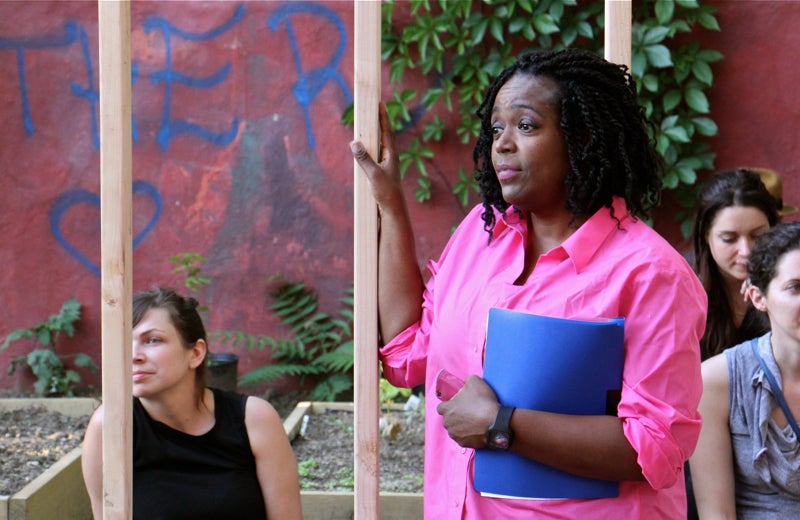
Her play “Neighbors?” was performed in August in a community garden in the Kensington neighborhood, where the museum had a mock rowhome built to house exhibits and workshops around ideas of gentrification. That was the main topic of Washington’s pop-up play.
“I don’t know if you’ve been in Kensington lately, but every single block has new construction going up,” she said. “It’s amazing. I’ve had two flat tires.”
Washington pulled together ideas from “Neighbors?” and the other 11 plays to write “Lacunae,” to be performed in the Philadelphia Assembled exhibition space in the museum’s Perelman Building, where that same mock rowhome from Kensington had been reassembled.
The play has plenty of its own lacunae: wiggle room for the actors to go off script.
“Actors are free to improvise,” she said. “But we had to be more conventional in the museum.”
That Philadelphia Assembled exists at all is a minor miracle; it’s a clash between institutionalized curatorial practices of the Philadelphia Museum of Art — the “Palace on the Hill” — and the staunchly progressive, independent practices of neighborhood artists and activists.
“There’s a lot of bad blood about the museum, and rightly so,” said Washington. “I’m still in shock they pulled this off. It involved such a large number of artists and citizens and ideologies.”
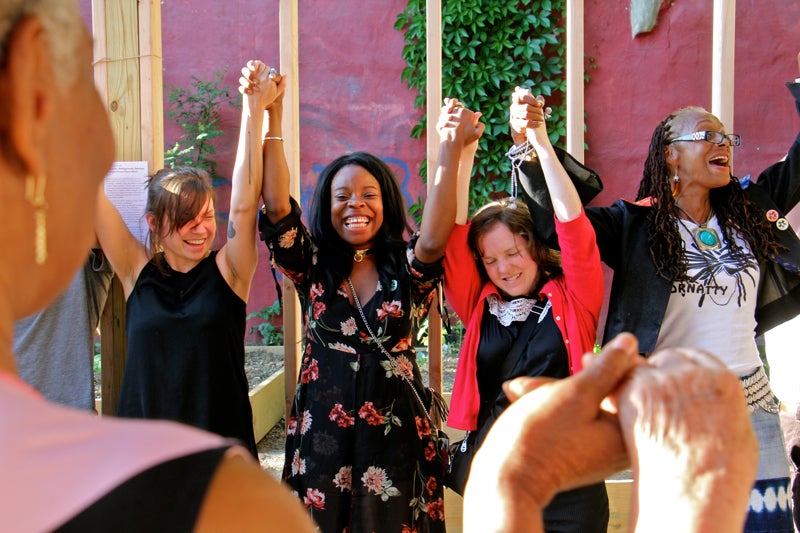
Philadelphia Assembled was masterminded by the Dutch artist Jeanne van Heeswijk at the invitation of the art museum, but neither van Heeswijk nor the museum claim to have control over it. It is a decentralized network of community artists and activists who determined what they were going to do and how, with ample support from the museum.
It was not always a smooth collaboration. Many of the participants did not come into the project as fans of the museum.
“I was one of those people,” said Denise Valentine, an artist and storyteller who lives in the West Oak Lane neighborhood. “I did visit the museum before, but I have never felt welcomed there. I have never felt included in the Philadelphia Museum of Art.”
Ultimately, Valentine became one of the more active proponents of Philadelphia Assembled, but only after feeling secure about the working relationship with the museum.
“I had to have the assurance that no one was going to tell me what to say, or what to do — that I would be speaking in my own voice,” she said. “I really felt as though the museum gave me room to do that.”
The understanding had to go the other way, too. The museum had to have confidence that the network of artists would be able to create something worthy of exhibition, on a certain timeline.
The resulting exhibition, which opened in September, took over the entirety of the Perelman Building. It forced the museum to be flexible and relinquish control — two things a large cultural institution is not accustomed to do.
“This was an exercise in community engagement at full force, maybe community engagement on steroids,” said Damon Reaves, the museum’s associate curator of education for community engagement and access.
Nearly every department of the museum had to alter the way it operates to accommodate the demands of Philadelphia Assembled. From curatorial, to design and production, to cafeteria services, to security, all departments had to be flexible.
“For us, as an institution, it’s been life-changing and profound,” said Reaves. “We’re humbled to participate in this kind of conversation and grateful the collaborators allowed us to participate. We want to be part of that civic dialogue.”
This is the final weekend of Philadelphia Assembled. After years of work has been done to establish relationships, to spark new dialogues, and to build an exhibition, what now?
All the collaborators — including the museum — are attending meetings about how to perpetuate the collaboration. Right now, nobody knows for certain how to do that, particularly as the museum will not be able to maintain the same level of support.
“There are many parts of Philadelphia Assembled that just gave us so much life, and we want to continue,” said Valentine. “To be honest, we have no idea whether it can continue in the same form. We won’t have those resources available in the same way, but at least now we’ve all seen what’s possible.”
WHYY is your source for fact-based, in-depth journalism and information. As a nonprofit organization, we rely on financial support from readers like you. Please give today.



